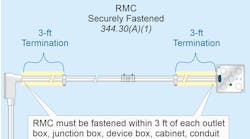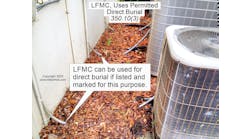Courtesy of www.MikeHolt.com
Q. What are the conditions electrical metallic tubing (EMT) can be used and installed?
See answer below.
A. The conditions where EMT can be used and installed are listed in Sec. 358.10.
(A) Exposed and Concealed. EMT is permitted to be used exposed and concealed for the following applications:
(1) In concrete in direct contact with the earth in accordance with Sec. 358.10(B).
(2) In dry, damp, or wet locations.
(3) In any hazardous (classified) location as permitted by other articles in this Code.
(B) Corrosive Environments.
(1) Galvanized Steel. Galvanized steel EMT, elbows, and fittings can be installed in concrete, in direct contact with the earth, or in areas subject to severe corrosive influences if protected by corrosion protection and approved as suitable for the condition [Sec. 300.6(A)].
Author’s Comment: If installed in wet locations, fittings for EMT must be listed for use in wet locations and prevent moisture or water from entering or accumulating within the enclosure in accordance with Sec. 314.15 [Sec. 358.42].
(D) Wet Locations. Support fittings such as screws, straps, and so on, installed in a wet location must be made of corrosion-resistant material.
These materials are provided to us by Mike Holt Enterprises in Leesburg, Fla. To view Code training materials offered by this company, visit www.mikeholt.com/code.





